# Objective
- Use the prepass textures in webgl
## Solution
- Bind the prepass textures even when using webgl, but only if msaa is disabled
- Also did some refactors to centralize how textures are bound, similar to the EnvironmentMapLight PR
- ~~Also did some refactors of the example to make it work in webgl~~
- ~~To make the example work in webgl, I needed to use a sampler for the depth texture, the resulting code looks a bit weird, but it's simple enough and I think it's worth it to show how it works when using webgl~~
# Objective
UIs created for Bevy cannot currently be made accessible. This PR aims to address that.
## Solution
Integrate AccessKit as a dependency, adding accessibility support to existing bevy_ui widgets.
## Changelog
### Added
* Integrate with and expose [AccessKit](https://accesskit.dev) for platform accessibility.
* Add `Label` for marking text specifically as a label for UI controls.
# Objective
- Fixes#1800, fixes#6984
- Alternative to #7196
- Ensure feature list is always up to date and that all are documented
- Help discovery of features
## Solution
- Use a template to update the cargo feature list
- Use the comment just above the feature declaration as the description
- Add the checks to CI
- Add the features to the base crate doc
# Objective
This PR adds an example that shows how to use `apply_system_buffers` and how to order it with respect to the relevant systems. It also shows how not ordering the systems can lead to unexpected behaviours.
## Solution
Add the example.
# Objective
- Add basic spatial audio support to Bevy
- this is what rodio supports, so no HRTF, just simple stereo channel manipulation
- no "built-in" ECS support: `Emitter` and `Listener` should be components that would automatically update the positions
This PR goal is to just expose rodio functionality, made possible with the recent update to rodio 0.16. A proper ECS integration opens a lot more questions, and would probably require an RFC
Also updates rodio and fixes#6122
# Objective
Splits tone mapping from https://github.com/bevyengine/bevy/pull/6677 into a separate PR.
Address https://github.com/bevyengine/bevy/issues/2264.
Adds tone mapping options:
- None: Bypasses tonemapping for instances where users want colors output to match those set.
- Reinhard
- Reinhard Luminance: Bevy's exiting tonemapping
- [ACES](https://github.com/TheRealMJP/BakingLab/blob/master/BakingLab/ACES.hlsl) (Fitted version, based on the same implementation that Godot 4 uses) see https://github.com/bevyengine/bevy/issues/2264
- [AgX](https://github.com/sobotka/AgX)
- SomewhatBoringDisplayTransform
- TonyMcMapface
- Blender Filmic
This PR also adds support for EXR images so they can be used to compare tonemapping options with reference images.
## Migration Guide
- Tonemapping is now an enum with NONE and the various tonemappers.
- The DebandDither is now a separate component.
Co-authored-by: JMS55 <47158642+JMS55@users.noreply.github.com>
# Objective
- Environment maps use these formats, and in the future rendering LUTs will need textures loaded by default in the engine
## Solution
- Make ktx2 and zstd part of the default feature
- Let examples assume these features are enabled
---
## Changelog
- `ktx2` and `zstd` are now party of bevy's default enabled features
## Migration Guide
- If you used the `ktx2` or `zstd` features, you no longer need to explicitly enable them, as they are now part of bevy's default enabled features
Profiles show that in extremely hot loops, like the draw loops in the renderer, invoking the trace! macro has noticeable overhead, even if the trace log level is not enabled.
Solve this by introduce a 'wrapper' detailed_trace macro around trace, that wraps the trace! log statement in a trivially false if statement unless a cargo feature is enabled
# Objective
- Eliminate significant overhead observed with trace-level logging in render hot loops, even when trace log level is not enabled.
- This is an alternative solution to the one proposed in #7223
## Solution
- Introduce a wrapper around the `trace!` macro called `detailed_trace!`. This macro wraps the `trace!` macro with an if statement that is conditional on a new cargo feature, `detailed_trace`. When the feature is not enabled (the default), then the if statement is trivially false and should be optimized away at compile time.
- Convert the observed hot occurrences of trace logging in `TrackedRenderPass` with this new macro.
Testing the results of
```
cargo run --profile stress-test --features bevy/trace_tracy --example many_cubes -- spheres
```
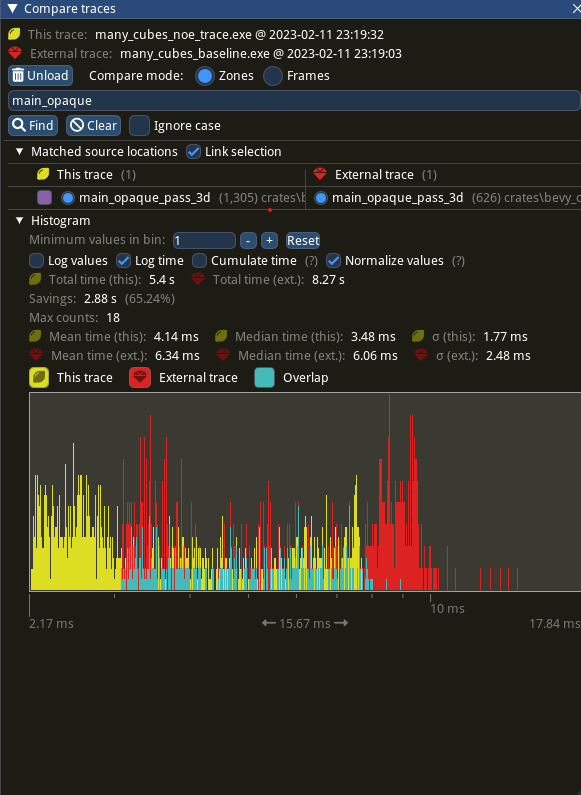
shows significant improvement of the `main_opaque_pass_3d` of the renderer, a median time decrease from 6.0ms to 3.5ms.
---
## Changelog
- For performance reasons, some detailed renderer trace logs now require the use of cargo feature `detailed_trace` in addition to setting the log level to `TRACE` in order to be shown.
## Migration Guide
- Some detailed bevy trace events now require the use of the cargo feature `detailed_trace` in addition to enabling `TRACE` level logging to view. Should you wish to see these logs, please compile your code with the bevy feature `detailed_trace`. Currently, the only logs that are affected are the renderer logs pertaining to `TrackedRenderPass` functions
# Objective
- Required features were added to some examples in #7051 even though those features aren't the main focus of the examples
- Don't require features on examples that are useful without them
## Solution
- Remove required features on examples `load_gltf` and `scene_viewer`, but log a warning when they are not enabled
(Before)
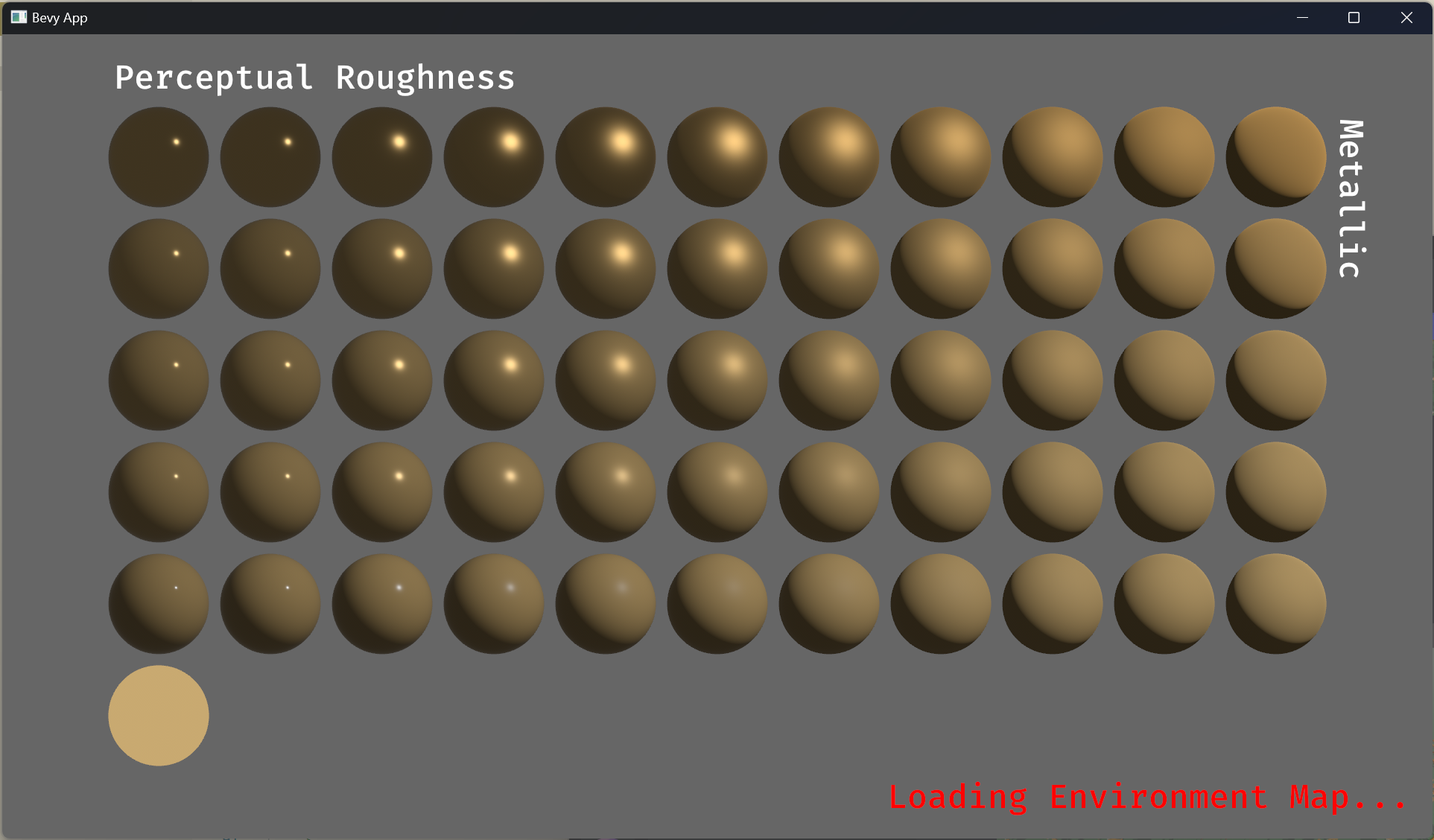
(After)
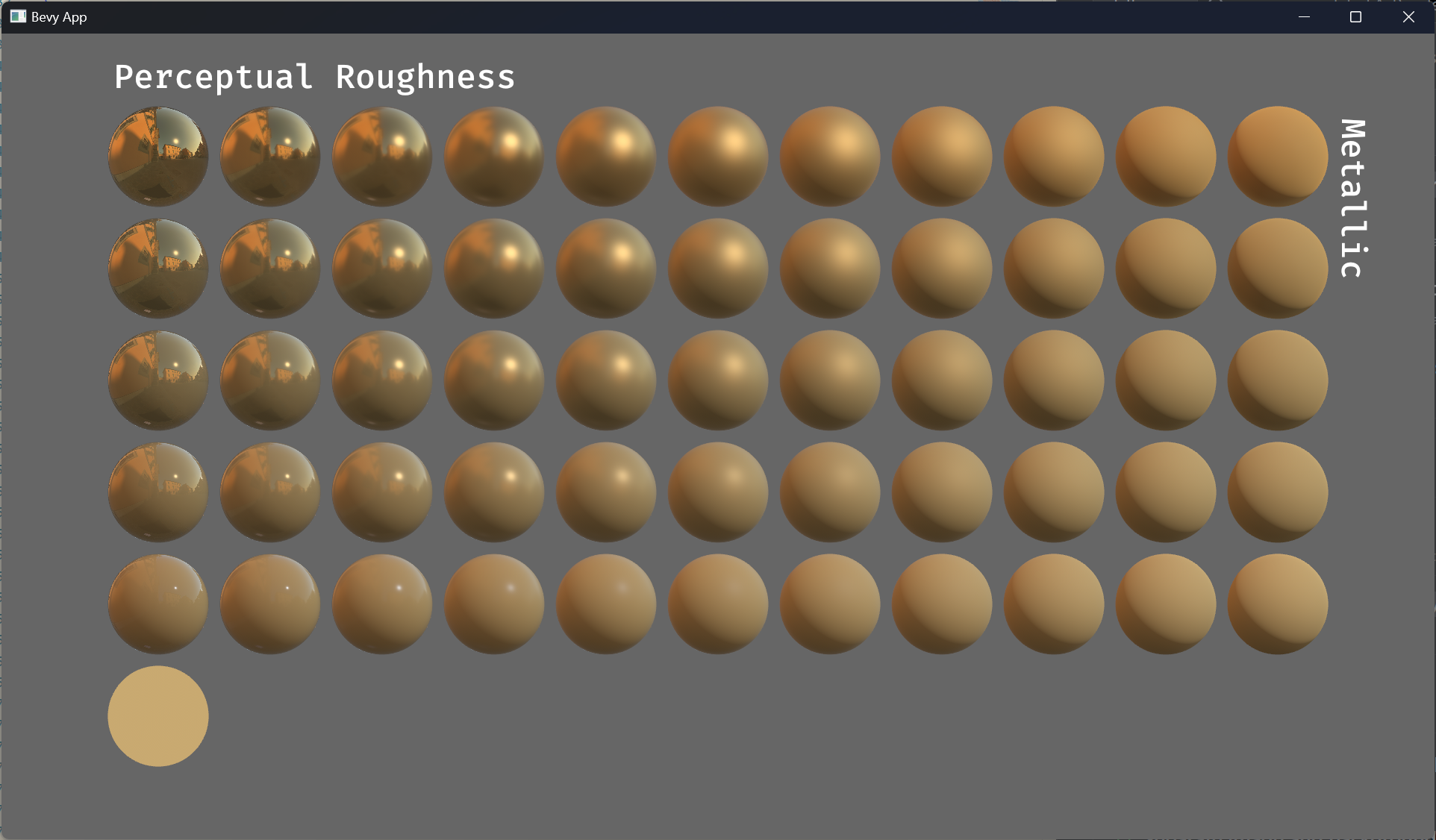
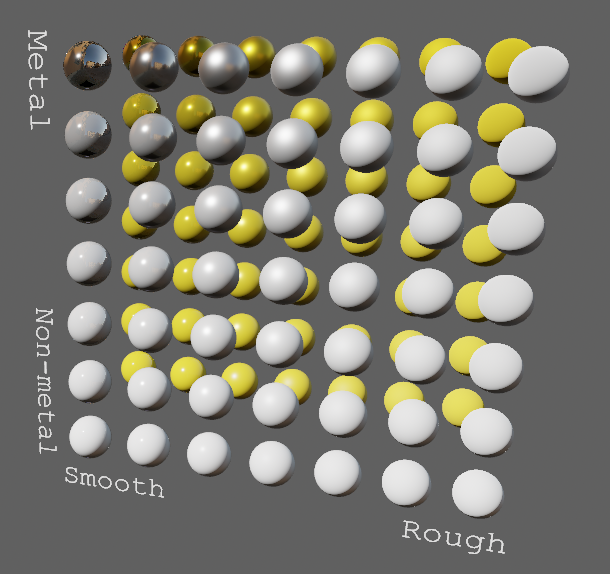
# Objective
- Improve lighting; especially reflections.
- Closes https://github.com/bevyengine/bevy/issues/4581.
## Solution
- Implement environment maps, providing better ambient light.
- Add microfacet multibounce approximation for specular highlights from Filament.
- Occlusion is no longer incorrectly applied to direct lighting. It now only applies to diffuse indirect light. Unsure if it's also supposed to apply to specular indirect light - the glTF specification just says "indirect light". In the case of ambient occlusion, for instance, that's usually only calculated as diffuse though. For now, I'm choosing to apply this just to indirect diffuse light, and not specular.
- Modified the PBR example to use an environment map, and have labels.
- Added `FallbackImageCubemap`.
## Implementation
- IBL technique references can be found in environment_map.wgsl.
- It's more accurate to use a LUT for the scale/bias. Filament has a good reference on generating this LUT. For now, I just used an analytic approximation.
- For now, environment maps must first be prefiltered outside of bevy using a 3rd party tool. See the `EnvironmentMap` documentation.
- Eventually, we should have our own prefiltering code, so that we can have dynamically changing environment maps, as well as let users drop in an HDR image and use asset preprocessing to create the needed textures using only bevy.
---
## Changelog
- Added an `EnvironmentMapLight` camera component that adds additional ambient light to a scene.
- StandardMaterials will now appear brighter and more saturated at high roughness, due to internal material changes. This is more physically correct.
- Fixed StandardMaterial occlusion being incorrectly applied to direct lighting.
- Added `FallbackImageCubemap`.
Co-authored-by: IceSentry <c.giguere42@gmail.com>
Co-authored-by: James Liu <contact@jamessliu.com>
Co-authored-by: Rob Parrett <robparrett@gmail.com>
# Objective
- Merge the examples on iOS and Android
- Make sure they both work from the same code
## Solution
- don't create window when not in an active state (from #6830)
- exit on suspend on Android (from #6830)
- automatically enable dependency feature of bevy_audio on android so that it works out of the box
- don't inverse y position of touch events
- reuse the same example for both Android and iOS
Fixes#4616Fixes#4103Fixes#3648Fixes#3458Fixes#3249Fixes#86
Huge thanks to @maniwani, @devil-ira, @hymm, @cart, @superdump and @jakobhellermann for the help with this PR.
# Objective
- Followup #6587.
- Minimal integration for the Stageless Scheduling RFC: https://github.com/bevyengine/rfcs/pull/45
## Solution
- [x] Remove old scheduling module
- [x] Migrate new methods to no longer use extension methods
- [x] Fix compiler errors
- [x] Fix benchmarks
- [x] Fix examples
- [x] Fix docs
- [x] Fix tests
## Changelog
### Added
- a large number of methods on `App` to work with schedules ergonomically
- the `CoreSchedule` enum
- `App::add_extract_system` via the `RenderingAppExtension` trait extension method
- the private `prepare_view_uniforms` system now has a public system set for scheduling purposes, called `ViewSet::PrepareUniforms`
### Removed
- stages, and all code that mentions stages
- states have been dramatically simplified, and no longer use a stack
- `RunCriteriaLabel`
- `AsSystemLabel` trait
- `on_hierarchy_reports_enabled` run criteria (now just uses an ad hoc resource checking run condition)
- systems in `RenderSet/Stage::Extract` no longer warn when they do not read data from the main world
- `RunCriteriaLabel`
- `transform_propagate_system_set`: this was a nonstandard pattern that didn't actually provide enough control. The systems are already `pub`: the docs have been updated to ensure that the third-party usage is clear.
### Changed
- `System::default_labels` is now `System::default_system_sets`.
- `App::add_default_labels` is now `App::add_default_sets`
- `CoreStage` and `StartupStage` enums are now `CoreSet` and `StartupSet`
- `App::add_system_set` was renamed to `App::add_systems`
- The `StartupSchedule` label is now defined as part of the `CoreSchedules` enum
- `.label(SystemLabel)` is now referred to as `.in_set(SystemSet)`
- `SystemLabel` trait was replaced by `SystemSet`
- `SystemTypeIdLabel<T>` was replaced by `SystemSetType<T>`
- The `ReportHierarchyIssue` resource now has a public constructor (`new`), and implements `PartialEq`
- Fixed time steps now use a schedule (`CoreSchedule::FixedTimeStep`) rather than a run criteria.
- Adding rendering extraction systems now panics rather than silently failing if no subapp with the `RenderApp` label is found.
- the `calculate_bounds` system, with the `CalculateBounds` label, is now in `CoreSet::Update`, rather than in `CoreSet::PostUpdate` before commands are applied.
- `SceneSpawnerSystem` now runs under `CoreSet::Update`, rather than `CoreStage::PreUpdate.at_end()`.
- `bevy_pbr::add_clusters` is no longer an exclusive system
- the top level `bevy_ecs::schedule` module was replaced with `bevy_ecs::scheduling`
- `tick_global_task_pools_on_main_thread` is no longer run as an exclusive system. Instead, it has been replaced by `tick_global_task_pools`, which uses a `NonSend` resource to force running on the main thread.
## Migration Guide
- Calls to `.label(MyLabel)` should be replaced with `.in_set(MySet)`
- Stages have been removed. Replace these with system sets, and then add command flushes using the `apply_system_buffers` exclusive system where needed.
- The `CoreStage`, `StartupStage, `RenderStage` and `AssetStage` enums have been replaced with `CoreSet`, `StartupSet, `RenderSet` and `AssetSet`. The same scheduling guarantees have been preserved.
- Systems are no longer added to `CoreSet::Update` by default. Add systems manually if this behavior is needed, although you should consider adding your game logic systems to `CoreSchedule::FixedTimestep` instead for more reliable framerate-independent behavior.
- Similarly, startup systems are no longer part of `StartupSet::Startup` by default. In most cases, this won't matter to you.
- For example, `add_system_to_stage(CoreStage::PostUpdate, my_system)` should be replaced with
- `add_system(my_system.in_set(CoreSet::PostUpdate)`
- When testing systems or otherwise running them in a headless fashion, simply construct and run a schedule using `Schedule::new()` and `World::run_schedule` rather than constructing stages
- Run criteria have been renamed to run conditions. These can now be combined with each other and with states.
- Looping run criteria and state stacks have been removed. Use an exclusive system that runs a schedule if you need this level of control over system control flow.
- For app-level control flow over which schedules get run when (such as for rollback networking), create your own schedule and insert it under the `CoreSchedule::Outer` label.
- Fixed timesteps are now evaluated in a schedule, rather than controlled via run criteria. The `run_fixed_timestep` system runs this schedule between `CoreSet::First` and `CoreSet::PreUpdate` by default.
- Command flush points introduced by `AssetStage` have been removed. If you were relying on these, add them back manually.
- Adding extract systems is now typically done directly on the main app. Make sure the `RenderingAppExtension` trait is in scope, then call `app.add_extract_system(my_system)`.
- the `calculate_bounds` system, with the `CalculateBounds` label, is now in `CoreSet::Update`, rather than in `CoreSet::PostUpdate` before commands are applied. You may need to order your movement systems to occur before this system in order to avoid system order ambiguities in culling behavior.
- the `RenderLabel` `AppLabel` was renamed to `RenderApp` for clarity
- `App::add_state` now takes 0 arguments: the starting state is set based on the `Default` impl.
- Instead of creating `SystemSet` containers for systems that run in stages, simply use `.on_enter::<State::Variant>()` or its `on_exit` or `on_update` siblings.
- `SystemLabel` derives should be replaced with `SystemSet`. You will also need to add the `Debug`, `PartialEq`, `Eq`, and `Hash` traits to satisfy the new trait bounds.
- `with_run_criteria` has been renamed to `run_if`. Run criteria have been renamed to run conditions for clarity, and should now simply return a bool.
- States have been dramatically simplified: there is no longer a "state stack". To queue a transition to the next state, call `NextState::set`
## TODO
- [x] remove dead methods on App and World
- [x] add `App::add_system_to_schedule` and `App::add_systems_to_schedule`
- [x] avoid adding the default system set at inappropriate times
- [x] remove any accidental cycles in the default plugins schedule
- [x] migrate benchmarks
- [x] expose explicit labels for the built-in command flush points
- [x] migrate engine code
- [x] remove all mentions of stages from the docs
- [x] verify docs for States
- [x] fix uses of exclusive systems that use .end / .at_start / .before_commands
- [x] migrate RenderStage and AssetStage
- [x] migrate examples
- [x] ensure that transform propagation is exported in a sufficiently public way (the systems are already pub)
- [x] ensure that on_enter schedules are run at least once before the main app
- [x] re-enable opt-in to execution order ambiguities
- [x] revert change to `update_bounds` to ensure it runs in `PostUpdate`
- [x] test all examples
- [x] unbreak directional lights
- [x] unbreak shadows (see 3d_scene, 3d_shape, lighting, transparaency_3d examples)
- [x] game menu example shows loading screen and menu simultaneously
- [x] display settings menu is a blank screen
- [x] `without_winit` example panics
- [x] ensure all tests pass
- [x] SubApp doc test fails
- [x] runs_spawn_local tasks fails
- [x] [Fix panic_when_hierachy_cycle test hanging](https://github.com/alice-i-cecile/bevy/pull/120)
## Points of Difficulty and Controversy
**Reviewers, please give feedback on these and look closely**
1. Default sets, from the RFC, have been removed. These added a tremendous amount of implicit complexity and result in hard to debug scheduling errors. They're going to be tackled in the form of "base sets" by @cart in a followup.
2. The outer schedule controls which schedule is run when `App::update` is called.
3. I implemented `Label for `Box<dyn Label>` for our label types. This enables us to store schedule labels in concrete form, and then later run them. I ran into the same set of problems when working with one-shot systems. We've previously investigated this pattern in depth, and it does not appear to lead to extra indirection with nested boxes.
4. `SubApp::update` simply runs the default schedule once. This sucks, but this whole API is incomplete and this was the minimal changeset.
5. `time_system` and `tick_global_task_pools_on_main_thread` no longer use exclusive systems to attempt to force scheduling order
6. Implemetnation strategy for fixed timesteps
7. `AssetStage` was migrated to `AssetSet` without reintroducing command flush points. These did not appear to be used, and it's nice to remove these bottlenecks.
8. Migration of `bevy_render/lib.rs` and pipelined rendering. The logic here is unusually tricky, as we have complex scheduling requirements.
## Future Work (ideally before 0.10)
- Rename schedule_v3 module to schedule or scheduling
- Add a derive macro to states, and likely a `EnumIter` trait of some form
- Figure out what exactly to do with the "systems added should basically work by default" problem
- Improve ergonomics for working with fixed timesteps and states
- Polish FixedTime API to match Time
- Rebase and merge #7415
- Resolve all internal ambiguities (blocked on better tools, especially #7442)
- Add "base sets" to replace the removed default sets.
# Objective
- Bevy should not have any "internal" execution order ambiguities. These clutter the output of user-facing error reporting, and can result in nasty, nondetermistic, very difficult to solve bugs.
- Verifying this currently involves repeated non-trivial manual work.
## Solution
- [x] add an example to quickly check this
- ~~[ ] ensure that this example panics if there are any unresolved ambiguities~~
- ~~[ ] run the example in CI 😈~~
There's one tricky ambiguity left, between UI and animation. I don't have the tools to fix this without system set configuration, so the remaining work is going to be left to #7267 or another PR after that.
```
2023-01-27T18:38:42.989405Z INFO bevy_ecs::schedule::ambiguity_detection: Execution order ambiguities detected, you might want to add an explicit dependency relation between some of these systems:
* Parallel systems:
-- "bevy_animation::animation_player" and "bevy_ui::flex::flex_node_system"
conflicts: ["bevy_transform::components::transform::Transform"]
```
## Changelog
Resolved internal execution order ambiguities for:
1. Transform propagation (ignored, we need smarter filter checking).
2. Gamepad processing (fixed).
3. bevy_winit's window handling (fixed).
4. Cascaded shadow maps and perspectives (fixed).
Also fixed a desynchronized state bug that could occur when the `Window` component is removed and then added to the same entity in a single frame.
# Objective
- Fix#7315
- Add IME support
## Solution
- Add two new fields to `Window`, to control if IME is enabled and the candidate box position
This allows the use of dead keys which are needed in French, or the full IME experience to type using Pinyin
I also added a basic general text input example that can handle IME input.
https://user-images.githubusercontent.com/8672791/213941353-5ed73a73-5dd1-4e66-a7d6-a69b49694c52.mp4
<img width="1392" alt="image" src="https://user-images.githubusercontent.com/418473/203873533-44c029af-13b7-4740-8ea3-af96bd5867c9.png">
<img width="1392" alt="image" src="https://user-images.githubusercontent.com/418473/203873549-36be7a23-b341-42a2-8a9f-ceea8ac7a2b8.png">
# Objective
- Add support for the “classic” distance fog effect, as well as a more advanced atmospheric fog effect.
## Solution
This PR:
- Introduces a new `FogSettings` component that controls distance fog per-camera.
- Adds support for three widely used “traditional” fog falloff modes: `Linear`, `Exponential` and `ExponentialSquared`, as well as a more advanced `Atmospheric` fog;
- Adds support for directional light influence over fog color;
- Extracts fog via `ExtractComponent`, then uses a prepare system that sets up a new dynamic uniform struct (`Fog`), similar to other mesh view types;
- Renders fog in PBR material shader, as a final adjustment to the `output_color`, after PBR is computed (but before tone mapping);
- Adds a new `StandardMaterial` flag to enable fog; (`fog_enabled`)
- Adds convenience methods for easier artistic control when creating non-linear fog types;
- Adds documentation around fog.
---
## Changelog
### Added
- Added support for distance-based fog effects for PBR materials, controllable per-camera via the new `FogSettings` component;
- Added `FogFalloff` enum for selecting between three widely used “traditional” fog falloff modes: `Linear`, `Exponential` and `ExponentialSquared`, as well as a more advanced `Atmospheric` fog;
# Objective
Bump the MSRV to 1.67. Enable cleanup PRs like #7346 to work.
## Solution
Bump it to 1.67
---
## Changelog
Changed: The MSRV of the engine is now 1.67.
# Objective
Fixes#6952
## Solution
- Request WGPU capabilities `SAMPLED_TEXTURE_AND_STORAGE_BUFFER_ARRAY_NON_UNIFORM_INDEXING`, `SAMPLER_NON_UNIFORM_INDEXING` and `UNIFORM_BUFFER_AND_STORAGE_TEXTURE_ARRAY_NON_UNIFORM_INDEXING` when corresponding features are enabled.
- Add an example (`shaders/texture_binding_array`) illustrating (and testing) the use of non-uniform indexed textures and samplers.
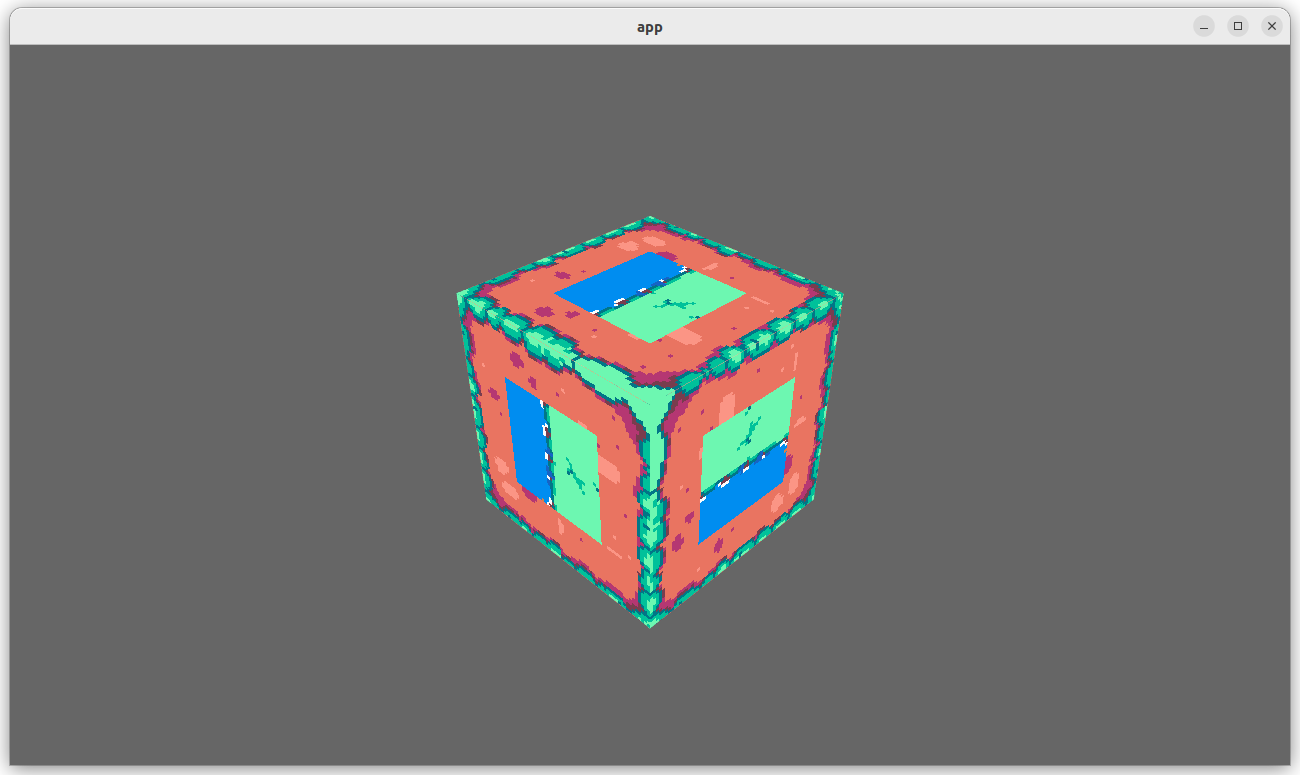
## Changelog
- Added new capabilities for shader validation.
- Added example `shaders/texture_binding_array`.
# Problemo
Some code in #5911 and #5454 does not compile with dynamic linking enabled.
The code is behind a feature gate to prevent dynamically linked builds from breaking, but it's not quite set up correctly.
## Solution
Forward the `dynamic` feature flag to the `bevy_diagnostic` crate and gate the code behind it.
Co-authored-by: devil-ira <justthecooldude@gmail.com>
# Objective
- This PR adds support for blend modes to the PBR `StandardMaterial`.
<img width="1392" alt="Screenshot 2022-11-18 at 20 00 56" src="https://user-images.githubusercontent.com/418473/202820627-0636219a-a1e5-437a-b08b-b08c6856bf9c.png">
<img width="1392" alt="Screenshot 2022-11-18 at 20 01 01" src="https://user-images.githubusercontent.com/418473/202820615-c8d43301-9a57-49c4-bd21-4ae343c3e9ec.png">
## Solution
- The existing `AlphaMode` enum is extended, adding three more modes: `AlphaMode::Premultiplied`, `AlphaMode::Add` and `AlphaMode::Multiply`;
- All new modes are rendered in the existing `Transparent3d` phase;
- The existing mesh flags for alpha mode are reorganized for a more compact/efficient representation, and new values are added;
- `MeshPipelineKey::TRANSPARENT_MAIN_PASS` is refactored into `MeshPipelineKey::BLEND_BITS`.
- `AlphaMode::Opaque` and `AlphaMode::Mask(f32)` share a single opaque pipeline key: `MeshPipelineKey::BLEND_OPAQUE`;
- `Blend`, `Premultiplied` and `Add` share a single premultiplied alpha pipeline key, `MeshPipelineKey::BLEND_PREMULTIPLIED_ALPHA`. In the shader, color values are premultiplied accordingly (or not) depending on the blend mode to produce the three different results after PBR/tone mapping/dithering;
- `Multiply` uses its own independent pipeline key, `MeshPipelineKey::BLEND_MULTIPLY`;
- Example and documentation are provided.
---
## Changelog
### Added
- Added support for additive and multiplicative blend modes in the PBR `StandardMaterial`, via `AlphaMode::Add` and `AlphaMode::Multiply`;
- Added support for premultiplied alpha in the PBR `StandardMaterial`, via `AlphaMode::Premultiplied`;
# Objective
- Add a configurable prepass
- A depth prepass is useful for various shader effects and to reduce overdraw. It can be expansive depending on the scene so it's important to be able to disable it if you don't need any effects that uses it or don't suffer from excessive overdraw.
- The goal is to eventually use it for things like TAA, Ambient Occlusion, SSR and various other techniques that can benefit from having a prepass.
## Solution
The prepass node is inserted before the main pass. It runs for each `Camera3d` with a prepass component (`DepthPrepass`, `NormalPrepass`). The presence of one of those components is used to determine which textures are generated in the prepass. When any prepass is enabled, the depth buffer generated will be used by the main pass to reduce overdraw.
The prepass runs for each `Material` created with the `MaterialPlugin::prepass_enabled` option set to `true`. You can overload the shader used by the prepass by using `Material::prepass_vertex_shader()` and/or `Material::prepass_fragment_shader()`. It will also use the `Material::specialize()` for more advanced use cases. It is enabled by default on all materials.
The prepass works on opaque materials and materials using an alpha mask. Transparent materials are ignored.
The `StandardMaterial` overloads the prepass fragment shader to support alpha mask and normal maps.
---
## Changelog
- Add a new `PrepassNode` that runs before the main pass
- Add a `PrepassPlugin` to extract/prepare/queue the necessary data
- Add a `DepthPrepass` and `NormalPrepass` component to control which textures will be created by the prepass and available in later passes.
- Add a new `prepass_enabled` flag to the `MaterialPlugin` that will control if a material uses the prepass or not.
- Add a new `prepass_enabled` flag to the `PbrPlugin` to control if the StandardMaterial uses the prepass. Currently defaults to false.
- Add `Material::prepass_vertex_shader()` and `Material::prepass_fragment_shader()` to control the prepass from the `Material`
## Notes
In bevy's sample 3d scene, the performance is actually worse when enabling the prepass, but on more complex scenes the performance is generally better. I would like more testing on this, but @DGriffin91 has reported a very noticeable improvements in some scenes.
The prepass is also used by @JMS55 for TAA and GTAO
discord thread: <https://discord.com/channels/691052431525675048/1011624228627419187>
This PR was built on top of the work of multiple people
Co-Authored-By: @superdump
Co-Authored-By: @robtfm
Co-Authored-By: @JMS55
Co-authored-by: Charles <IceSentry@users.noreply.github.com>
Co-authored-by: JMS55 <47158642+JMS55@users.noreply.github.com>
# Objective
- Fixes#6361
- Fixes#6362
- Fixes#6364
## Solution
- Added an example for creating a custom `Decodable` type
- Clarified the documentation on `Decodable`
- Added an `AddAudioSource` trait and implemented it for `App`
Co-authored-by: dis-da-moe <84386186+dis-da-moe@users.noreply.github.com>
# Objective
Add useful information about cursor position relative to a UI node. Fixes#7079.
## Solution
- Added a new `RelativeCursorPosition` component
---
## Changelog
- Added
- `RelativeCursorPosition`
- an example showcasing the new component
Co-authored-by: Dawid Piotrowski <41804418+Pietrek14@users.noreply.github.com>
# Objective
It is possible to manually update `GlobalTransform`.
The engine actually assumes this is not possible.
For example, `propagate_transform` does not update children
of an `Entity` which **`GlobalTransform`** changed,
leading to unexpected behaviors.
A `GlobalTransform` set by the user may also be blindly
overwritten by the propagation system.
## Solution
- Remove `translation_mut`
- Explain to users that they shouldn't manually update the `GlobalTransform`
- Remove `global_vs_local.rs` example, since it misleads users
in believing that it is a valid use-case to manually update the
`GlobalTransform`
---
## Changelog
- Remove `GlobalTransform::translation_mut`
## Migration Guide
`GlobalTransform::translation_mut` has been removed without alternative,
if you were relying on this, update the `Transform` instead. If the given entity
had children or parent, you may need to remove its parent to make its transform
independent (in which case the new `Commands::set_parent_in_place` and
`Commands::remove_parent_in_place` may be of interest)
Bevy may add in the future a way to toggle transform propagation on
an entity basis.
# Objective
- Fixes#6777, fixes#2998, replaces #5518
- Help avoid confusing error message when using an older version of Rust
## Solution
- Add the `rust-version` field to `Cargo.toml`
- Add a CI job checking the MSRV
- Add the job to bors
# Objective
There isn't really a way to test that code using bevy_reflect compiles or doesn't compile for certain scenarios. This would be especially useful for macro-centric PRs like #6511 and #6042.
## Solution
Using `bevy_ecs_compile_fail_tests` as reference, added the `bevy_reflect_compile_fail_tests` crate.
Currently, this crate contains a very simple test case. This is so that we can get the basic foundation of this crate agreed upon and merged so that more tests can be added by other PRs.
### Open Questions
- [x] Should this be added to CI? (Answer: Yes)
---
## Changelog
- Added the `bevy_reflect_compile_fail_tests` crate for testing compilation errors
# Objective
This PR reorganizes majority of the scene viewer example into a module of plugins which then allows reuse of functionality among new or existing examples. In addition, this enables the scene viewer to be more succinct and showcase the distinct cases of camera control and scene control.
This work is to support future work in organization and future examples. A more complicated 3D scene example has been requested by the community (#6551) which requests functionality currently included in scene_viewer, but previously inaccessible. The future example can now just utilize the two plugins created here. The existing example [animated_fox example] can utilize the scene creation and animation control functionality of `SceneViewerPlugin`.
## Solution
- Created a `scene_viewer` module inside the `tools` example folder.
- Created two plugins: `SceneViewerPlugin` (gltf scene loading, animation control, camera tracking control, light control) and `CameraControllerPlugin` (controllable camera).
- Original `scene_viewer.rs` moved to `scene_viewer/main.rs` and now utilizes the two plugins.
# Objective
This adds a custom profile for testing against stress tests. Bevy seemingly gets notably faster with LTO turned on. To more accurately depict production level performance, LTO and other rustc-level optimizations should be enabled when performance testing on stress tests.
Also updated the stress test docs to reflect that users should be using it.
# Objective
The feature doesn't have any use case in libraries or applications and many users use this feature incorrectly. See the issue for details.
Closes#5753.
## Solution
Remove it.
---
## Changelog
### Removed
- `render` feature group.
## Migration Guide
Instead of using `render` feature group use dependencies directly. This group consisted of `bevy_core_pipeline`, `bevy_pbr`, `bevy_gltf`, `bevy_render`, `bevy_sprite`, `bevy_text` and `bevy_ui`. You probably want to check if you need all of them.
# Objective
- Fix CI issue with updated `cargo-app`
## Solution
- Move the Android example to its own package. It's not necessary for the CI fix, but it's cleaner, mimic the iOS example, and easier to reuse for someone wanting to setup android support in their project
- Build the package in CI instead of the example
The Android example is still working on my android device with this change 👍
# Objective
- Bevy should be usable to create 'overlay' type apps, where the input is not captured by Bevy, but passed down/into a target app, or to allow passive displays/widgets etc.
## Solution
- the `winit:🪟:Window` already has a `set_cursor_hittest()` which basically does this for mouse input events, so I've exposed it (trying to copy the style laid out in the existing wrappings, and added a simple demo.
---
## Changelog
- Added `hittest` to `WindowAttributes`
- Added the `hittest`'s setters/getters
- Modified the `WindowBuilder`
- Modifed the `WindowDescriptor`'s `Default` impl.
- Added an example `cargo run --example fallthrough`
# Objective
#6461 introduced `lto = true` as a profile setting for release builds. This is causing the `run-examples` CI task to timeout.
## Solution
Remove it.
# Objective
- Adds a bloom pass for HDR-enabled Camera3ds.
- Supersedes (and all credit due to!) https://github.com/bevyengine/bevy/pull/3430 and https://github.com/bevyengine/bevy/pull/2876
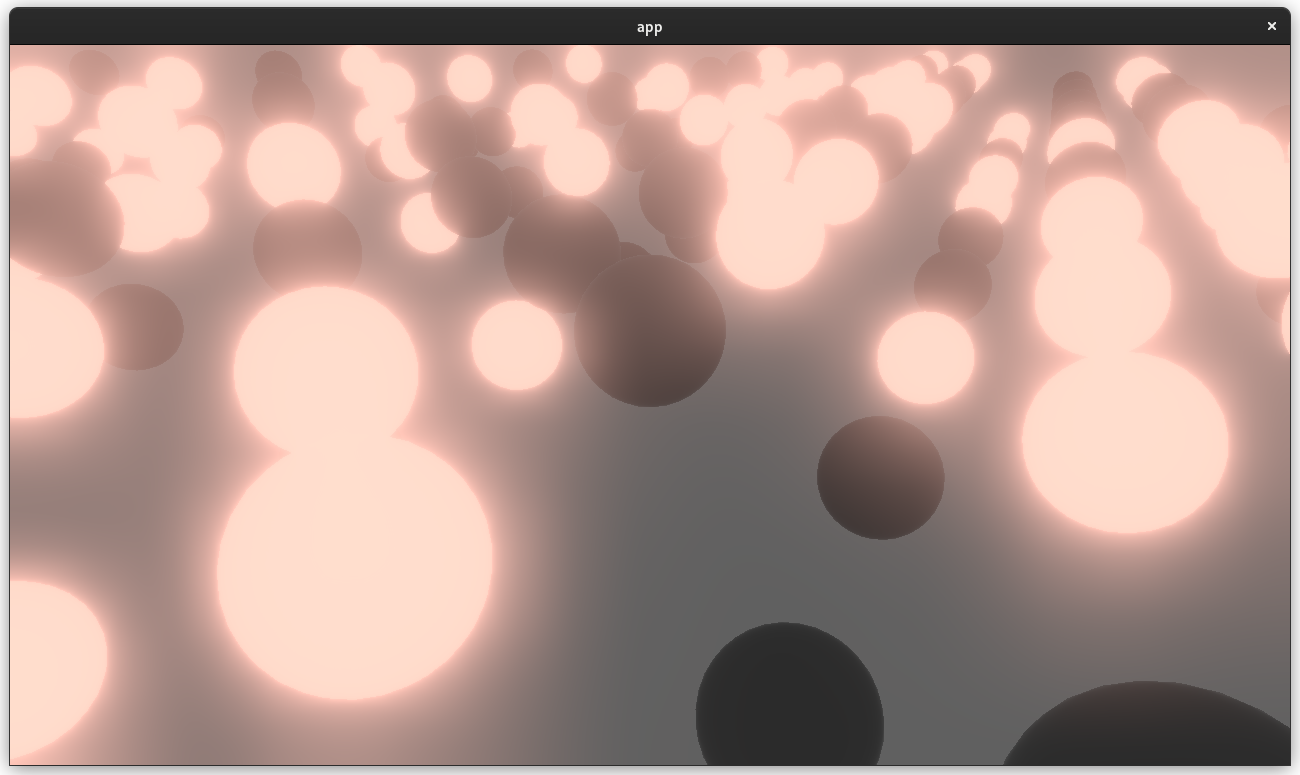
## Solution
- A threshold is applied to isolate emissive samples, and then a series of downscale and upscaling passes are applied and composited together.
- Bloom is applied to 2d or 3d Cameras with hdr: true and a BloomSettings component.
---
## Changelog
- Added a `core_pipeline::bloom::BloomSettings` component.
- Added `BloomNode` that runs between the main pass and tonemapping.
- Added a `BloomPlugin` that is loaded as part of CorePipelinePlugin.
- Added a bloom example project.
Co-authored-by: JMS55 <47158642+JMS55@users.noreply.github.com>
Co-authored-by: Carter Anderson <mcanders1@gmail.com>
Co-authored-by: DGriffin91 <github@dgdigital.net>
# Objective
Add consistent UI rendering and interaction where deep nodes inside two different hierarchies will never render on top of one-another by default and offer an escape hatch (z-index) for nodes to change their depth.
## The problem with current implementation
The current implementation of UI rendering is broken in that regard, mainly because [it sets the Z value of the `Transform` component based on a "global Z" space](https://github.com/bevyengine/bevy/blob/main/crates/bevy_ui/src/update.rs#L43) shared by all nodes in the UI. This doesn't account for the fact that each node's final `GlobalTransform` value will be relative to its parent. This effectively makes the depth unpredictable when two deep trees are rendered on top of one-another.
At the moment, it's also up to each part of the UI code to sort all of the UI nodes. The solution that's offered here does the full sorting of UI node entities once and offers the result through a resource so that all systems can use it.
## Solution
### New ZIndex component
This adds a new optional `ZIndex` enum component for nodes which offers two mechanism:
- `ZIndex::Local(i32)`: Overrides the depth of the node relative to its siblings.
- `ZIndex::Global(i32)`: Overrides the depth of the node relative to the UI root. This basically allows any node in the tree to "escape" the parent and be ordered relative to the entire UI.
Note that in the current implementation, omitting `ZIndex` on a node has the same result as adding `ZIndex::Local(0)`. Additionally, the "global" stacking context is essentially a way to add your node to the root stacking context, so using `ZIndex::Local(n)` on a root node (one without parent) will share that space with all nodes using `Index::Global(n)`.
### New UiStack resource
This adds a new `UiStack` resource which is calculated from both hierarchy and `ZIndex` during UI update and contains a vector of all node entities in the UI, ordered by depth (from farthest from camera to closest). This is exposed publicly by the bevy_ui crate with the hope that it can be used for consistent ordering and to reduce the amount of sorting that needs to be done by UI systems (i.e. instead of sorting everything by `global_transform.z` in every system, this array can be iterated over).
### New z_index example
This also adds a new z_index example that showcases the new `ZIndex` component. It's also a good general demo of the new UI stack system, because making this kind of UI was very broken with the old system (e.g. nodes would render on top of each other, not respecting hierarchy or insert order at all).
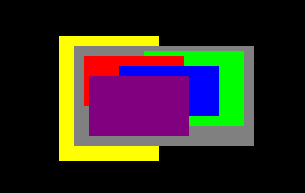
---
## Changelog
- Added the `ZIndex` component to bevy_ui.
- Added the `UiStack` resource to bevy_ui, and added implementation in a new `stack.rs` module.
- Removed the previous Z updating system from bevy_ui, because it was replaced with the above.
- Changed bevy_ui rendering to use UiStack instead of z ordering.
- Changed bevy_ui focus/interaction system to use UiStack instead of z ordering.
- Added a new z_index example.
## ZIndex demo
Here's a demo I wrote to test these features
https://user-images.githubusercontent.com/1060971/188329295-d7beebd6-9aee-43ab-821e-d437df5dbe8a.mp4
Co-authored-by: Carter Anderson <mcanders1@gmail.com>
# Objective
- Add post processing passes for FXAA (Fast Approximate Anti-Aliasing)
- Add example comparing MSAA and FXAA
## Solution
When the FXAA plugin is added, passes for FXAA are inserted between the main pass and the tonemapping pass. Supports using either HDR or LDR output from the main pass.
---
## Changelog
- Add a new FXAANode that runs after the main pass when the FXAA plugin is added.
Co-authored-by: Carter Anderson <mcanders1@gmail.com>
# Objective
To be consistent like other examples, it's better to keep file name and example name same, so we don't need to find correct example name in Cargo.toml.
## Solution
Rename example file scaling.rs to ui_scaling.rs.
# Objective
> System chaining is a confusing name: it implies the ability to construct non-linear graphs, and suggests a sense of system ordering that is only incidentally true. Instead, it actually works by passing data from one system to the next, much like the pipe operator.
> In the accepted [stageless RFC](https://github.com/bevyengine/rfcs/blob/main/rfcs/45-stageless.md), this concept is renamed to piping, and "system chaining" is used to construct groups of systems with ordering dependencies between them.
Fixes#6225.
## Changelog
System chaining has been renamed to system piping to improve clarity (and free up the name for new ordering APIs).
## Migration Guide
The `.chain(handler_system)` method on systems is now `.pipe(handler_system)`.
The `IntoChainSystem` trait is now `IntoPipeSystem`, and the `ChainSystem` struct is now `PipeSystem`.
# Objective
I was about to submit a PR to add these two examples to `bevy-website` and re-discovered the inconsistency.
Although it's not a major issue on the website where only the filenames are shown, this would help to visually distinguish the two examples in the list because the names are very prominent.
This also helps out when fuzzy-searching the codebase for these files.
## Solution
Rename `shapes` to `2d_shapes`. Now the filename matches the example name, and the naming structure matches the 3d example.
## Notes
@Nilirad proposed this in https://github.com/bevyengine/bevy/pull/4613#discussion_r862455631 but it had slipped away from my brain at that time.
# Objective
- Update ron to 0.8.0
- Fix breaking changes
- Closes#5862
## Solution
- Removed now non-existing method call (behavior is now the same without it)
# Objective
- Adopted from #3836
- Example showcases how to request a new resolution
- Example showcases how to react to resolution changes
Co-authored-by: Andreas Weibye <13300393+Weibye@users.noreply.github.com>
# Objective
- Allow users to change the scaling of the UI
- Adopted from #2808
## Solution
- This is an accessibility feature for fixed-size UI elements, allowing the developer to expose a range of UI scales for the player to set a scale that works for their needs.
> - The user can modify the UiScale struct to change the scaling at runtime. This multiplies the Px values by the scale given, while not touching any others.
> - The example showcases how this even allows for fluid transitions
> Here's how the example looks like:
https://user-images.githubusercontent.com/1631166/132979069-044161a9-8e85-45ab-9e93-fcf8e3852c2b.mp4
---
## Changelog
- Added a `UiScale` which can be used to scale all of UI
Co-authored-by: Andreas Weibye <13300393+Weibye@users.noreply.github.com>
Co-authored-by: Carter Anderson <mcanders1@gmail.com>